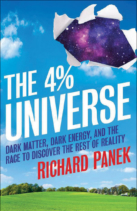By Richard Panek
Oneworld
Paperback: £9.99

The 4% Universe is, as you might gather from the title, an account of how the scientific community has come to the idea that only (a little over) 4% of the universe seems to be made of the same stuff as you and me. In other words, normal matter is only a tiny percentage of all that there is, with the remainder being about 23% dark matter holding galaxies together and 73% being dark energy, which drives the acceleration of cosmic expansion.
This account is unusual, written more like a thriller than in the style of many popularizations. There is a great emphasis on not only describing the sequences of events leading to the discoveries of dark matter and dark energy but also of the people involved. Personalities, co-operations, disagreements, collaboration and individualism all take a large part of the stage, making the book lively and readable. I had originally planned to read it in chunks over a few days but found myself taking it all in during a single sitting, somewhat later into the night than I had planned!
This book would be a nice gift for anyone with a genuine interest in science but, oddly enough, it may be a hard read for someone without at least some background knowledge. At the same time, it is short on details (no equations, graphs, plots or photographs) for a practising physicist who is not so interested in the personal dramas involved. If you’re looking for a book about dark matter and dark energy per se, then this may not be the best choice. While the science is probably more than 4% of the book, the bulk is about sociology, history and politics.
Nevertheless, technical terms are well explained, down to footnotes for those who need to know what the Kelvin scale or a megaparsec is. The physics is pretty good, too, but not perfect in all places. For example, the discussion on the Casimir effect seems not quite to get that the energy density between the plates is negative with respect to the region outside.
The emphasis is very much on astronomy and astronomical observation and how data are collected and presented. Particle physicists should not expect much about the direct search for particles that could make up dark matter. The LHC merits a brief mention but without further discussion. Axions and neutralinos are introduced as dark-matter candidates but without any explanation of the ideas that gave rise to them.
Apart from the insights into the sociology of how “big astronomy” is done, I think that the book’s greatest merit is to drive home how much our view of the universe has changed in the past 100 or so years – from a rather simple, static universe to an expanding, even accelerating one, with far more stars and galaxies than had ever been imagined and, now, the realization that all of that visible matter may be only a few per cent of all that is. That, as well as to show how cosmology has made the giant step from being little different from theology to being a real scientific discipline.





